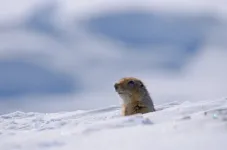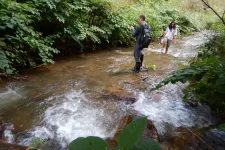(Press-News.org) Arctic ground squirrels are unique among mammals. Their ability to keep from freezing even when body temperatures dip below that mark on the thermometer enables them to survive extreme winter climates. New research published in Science analyzes more than 25 years of climate and biological data. The findings include shorter hibernation periods and differences between male and female hibernation periods. Spoiler alert - the girls “rise and shine” a little earlier in response to warming, which could have both positive and negative ripple effects throughout the food web in these ecosystems.
Senior author Cory Williams, assistant professor in the Department of Biology at Colorado State University, began studying arctic ground squirrels while at the University of Alaska Fairbanks more than 15 years ago. “I think the thing that makes our study unique is that we are looking at a long enough dataset to show the impacts of climate change on a mammal in the Arctic,” said Williams, who joined the CSU faculty in 2021. “We can show a direct link between changes in temperature and the physiology and ecology of these animals.”
Helen Chmura, lead author for this latest research, started the analysis while a postdoctoral fellow at the University of Alaska Fairbanks in 2018 and now works as a USDA Forest Service researcher with the Rocky Mountain Research Station. “Our data show that the active layer, the soil layer above the permafrost, freezes later in the fall, doesn’t get as cold in the middle of winter, and thaws slightly earlier in the spring.” She added, “These changes, amounting to about a 10-day reduction of the time soil is frozen at a meter deep, have occurred over just 25 years, which is fairly rapid.”
Arctic ground squirrels survive harsh Alaska winters by hibernating for over half the year, drastically slowing their lungs, heart, brain, and body functions. They still must spend energy to generate enough heat from stored fat to keep tissues from freezing. They resurface from their burrows more than 3 feet below the ground each spring, famished and eager to mate.
Chmura and Williams, along with co-authors, analyzed long-term air and soil temperature data at two sites in Arctic Alaska in conjunction with data collected using biologgers. They measured abdominal and/or skin temperature of 199 free-living individual ground squirrels over the same 25-year period. They found that females are changing when they end hibernation, emerging earlier every year, but males are not. Changes in females match earlier spring thaw. The advantage of this phenomenon is that they do not need to use as much stored fat during hibernation and can begin foraging for roots and shoots, berries and seeds sooner in the spring. Scientists think this could lead to healthier litters and higher survival rates.
The downside is that if the males also do not shift hibernation patterns, there eventually could be a mismatch in available “date nights” for the males and females. Ground squirrels are also an important source of food for many predators, such as foxes, wolves, and eagles. An indirect consequence of being active above ground longer is greater exposure and risk of being eaten.
What will happen to the population is a big unknown – there are not clear winners or losers. While hibernation requires less energy, which could help overwinter survival, ground squirrel numbers also depend on how predators respond to climate shifts. For now, Williams concludes, “Our paper shows the importance of long-term datasets in understanding how ecosystems are responding to climate change.” Chmura agreed, adding, “It takes a great team to continue a dataset like this for 25 years, especially in the Arctic.”
Other contributing authors include Brian Barnes, University of Alaska Fairbanks, and Loren Buck from Northern Arizona University, who both began this study in the 1990s to learn how Arctic ground squirrels survive such long, cold, dark, winters and just how cold their hibernation spots were. These questions prompted them to install the first soil temperature monitors, and as technology improved, they were able to measure those temperatures all winter long. Cassandra Duncan and Grace Burrell assisted with the research while students at the University of Alaska Fairbanks.
END
Arctic ground squirrels changing hibernation patterns
Unique long-term study helps us understand biological responses to climate shifts
2023-05-25
ELSE PRESS RELEASES FROM THIS DATE:
As Arctic warms, female arctic ground squirrels end hibernation before males – a mismatch with consequences
2023-05-25
As Alaskan permafrost warms, hibernating arctic ground squirrels generate less heat, causing females to emerge from hibernation up to 10 days before their male counterparts – a mismatch that could have large, cascading ecological impacts. The findings of the related study reveal both direct and indirect impacts of a warming world. Winter temperatures play a fundamental role in fitness and population dynamics for many species that live in higher latitudes. However, in the Arctic, where warming is occurring more rapidly than most other places on ...
Stressed soil microbial communities bolster tree resilience to changing climates
2023-05-25
Soil microbiota transplanted from more stressful environmental conditions – drought or excessive heat or cold, for example – can enhance tree tolerance to changing climates, researchers report. The findings suggest that management of soil microbiota, especially during forest restorations, could be a valuable strategy for increasing forest resilience to climate change. Climate change is forcing many species outside of their evolved range of environmental tolerances, forcing them to acclimate, adapt, or migrate to avoid extinction. For long-lived ...
Combining data types refines grasp of French Canadian ancestry in Quebec, revealing how local topographies influenced relatedness, and more
2023-05-25
Combining a comprehensive dataset – including marriage documents – compiled from more than 4 million Catholic parish records with genotype data for more than 22,000 French and French Canadian individuals, researchers have conducted a novel analysis of French Canadian ancestry in Quebec, Canada, since the 17th Century. While most other population genetic models provide only coarse representations of a region’s real-world ancestry, this new approach reveals detailed insights into historic European colonization, migration, and settlement patterns, reflecting intricate French Canadian population structures within geographic constraints. ...
International pandemic governance need not prioritize compliance and sanctions
2023-05-25
In a Policy Forum, Mark Eccleston-Turner and colleagues argue that upcoming negotiations surrounding the World Health Organization (WHO) international pandemic treaty need not be overly focused on formal compliance mechanisms and sanctions. Instead, Eccleston-Turner et al. suggest that any efforts to ensure compliance should be part of broader efforts to ensure effective and equitable implementation across all member states. Member states of the World Health Organization (WHO) are preparing for ambitious ...
River erosion can shape fish evolution, study suggests
2023-05-25
If we could rewind the tape of species evolution around the world and play it forward over hundreds of millions of years to the present day, we would see biodiversity clustering around regions of tectonic turmoil. Tectonically active regions such as the Himalayan and Andean mountains are especially rich in flora and fauna due to their shifting landscapes, which act to divide and diversify species over time.
But biodiversity can also flourish in some geologically quieter regions, where tectonics hasn’t shaken up the land for millennia. The Appalachian Mountains are a prime example: The range ...
River erosion drives fish biodiversity in the Appalachians
2023-05-25
New Haven, Conn. — The gradual erosion of layers of rock by rivers flowing through the Appalachian Mountains generates biodiversity of freshwater fish species, suggests a new Yale-led study that offers insight into the causes of species richness in the ancient mountain range.
Researchers have previously associated high biodiversity in mountain ranges, including the Andes and Himalaya, with tectonic uplift — the shifting of plates in the Earth’s crust that forms mountains, plateaus, and other geologic structures — triggering environmental changes that create conditions ripe for species diversification. ...
Researchers at the Faculty of Physics of the University of Warsaw have created a new, highly efficient converter of quantum information carriers
2023-05-25
Researchers at the University of Warsaw's Faculty of Physics have developed a new, highly efficient technique that makes quantum information transmission dozens of times faster. The results of the research, published in the prestigious journal Nature Photonics, may in the near future contribute to the development of superfast quantum Internet connections.
Light is a key carrier of information. It enables high-speed data transmission around the world via fiber-optic telecommunication networks. This information-carrying capability can be extended to transmitting quantum information by encoding ...
Making the structure of 'fire ice' with nanoparticles
2023-05-25
Images // Video
Cage structures made with nanoparticles could be a route toward making organized nanostructures with mixed materials, and researchers at the University of Michigan have shown how to achieve this through computer simulations.
The finding could open new avenues for photonic materials that manipulate light in ways that natural crystals can't. It also showcased an unusual effect that the team is calling entropy compartmentalization.
"We are developing new ways to structure ...
Large study provides scientists with deeper insight into long COVID symptoms
2023-05-25
Large study provides scientists with deeper insight into long COVID symptoms
NIH-funded research effort identifies most common symptoms, potential subgroups, and initial symptom-based scoring system – with aim of improving future diagnostics and treatment
Initial findings from a study of nearly 10,000 Americans, many of whom had COVID-19, have uncovered new details about long COVID, the post-infection set of conditions that can affect nearly every tissue and organ in the body. Clinical symptoms can vary and include fatigue, brain fog, and dizziness, and last for months or years after ...
Intravenous plus periarticular corticosteroids improve rehabilitation measures after knee replacement
2023-05-25
May 25, 2023 – For patients undergoing total knee arthroplasty (TKA), a combination of intravenous and periarticular corticosteroids does not improve pain control – but, may improve key indicators of functional recovery in the days after surgery, reports a trial in The Journal of Bone & Joint Surgery. The journal is published in the Lippincott portfolio in partnership with Wolters Kluwer.
Intravenous (IV) plus periarticular (PA) steroids "yielded more significant improvements in the rehabilitation parameters," ...
LAST 30 PRESS RELEASES:
Home fingertip oxygen monitors less accurate for people with darker skin tones
Six weeks in a cast no less effective than surgery for unstable ankle fractures
Precautionary approach to alcohol-free and low alcohol drinks needed to protect public health, say experts
Gas-atomized Ca–Mg alloy powders produce hydrogen simply by adding water — high-efficiency hydrogen generation at room temperature
British redcoat’s lost memoir reveals harsh realities of life as a disabled veteran
World-leading rare earth magnet recycling facility launches in UK
Corday Selden selected for the Oceanography Society Early Career Award
MIT chemists determine the structure of the fuzzy coat that surrounds Tau proteins
Same moves, different terrain: How bacteria navigate complex environments without changing their playbook
Severe weather is deadly for vulnerable older adults long after the storm ends, study finds
Expert panel highlights opportunities for improving cancer studies
Hearing aid prescriptions not associated with changes in memory and thinking
Seth Zippel selected for The Oceanography Society Early Career Award
Jeremy Horowitz selected for The Oceanography Society Early Career Award
Kennesaw State University’s Jerry Mack named Paul “Bear” Bryant Newcomer Coach of the Year
Ancient teeth are treasure troves of data on Iron Age lifestyles
Avocados may become easier to grow in India—but not if global emissions remain high
Pregnant women with IBD show heightened inflammation in vaginal mucosa
Underwater photos show seabirds, seals and fish interacting with a tidal turbine in Washington State
1 in 5 surveyed UK adults who have experienced the death of a pet report it as more distressing than experienced human deaths, with significant rates of prolonged grief disorder symptoms also being re
Polyester microfibers in soil negatively impact the development of cherry tomato plants in experiments, raising concerns over the potential effect of high levels of such contaminants
LGBTQ+ adults may be around twice as likely to be unemployed or to report workforce non-participation compared to heterosexual adults, per large representative Australian survey
Horses can smell fear: In experiments where horses smelled sweat from scared humans, they reacted to scary and sudden events with increased fear and reduced human interaction
New synaptic formation in adolescence challenges conventional views of brain development
Scientists identify target to treat devastating brain disease
Oliver Zielinski selected as Fellow of The Oceanography Society
Has progress stalled on gender equality at work?
Quantum simulator sheds light on how nature moves energy in systems like photosynthesis and solar conversion
Can a hashtag help prevent atrocities? Study shows social media can be a powerful tool
The American Ornithological Society (AOS) announces the winner of the 2025 Wesley Lanyon Award
[Press-News.org] Arctic ground squirrels changing hibernation patternsUnique long-term study helps us understand biological responses to climate shifts




